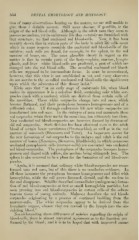Page 524 - My FlipBook
P. 524
534 DENTAL EMBRYOLOGY AND HISTOLOGY.
tion of many observations bearing on the matter, we are still unable to
give them a detinite answer. Still more obscure, if possible, is the
origin of the red blood-cells. Although in the adult man they seem to
possess no nucleus, yet in embryonic life they certainly are furnished with
that structure; we find nucleated red blood-cells. Now, it has been
recently shown that in certain parts of the body in adult life cells occur
which in many respects resemble the nucleated red blood-cells of the
embfyo; such cells are found, for example, in the spleen, in the red
marrow of bones, etc. The most plausible theory in regard to the
matter is that in certain parts of the body—spleen, marrow, lymph-
glands, and liver—white blood-cells are produced, a part of which are
changed into the red blood-cells. The so-called nucleated red blood-
cells are supposed to be intermediate forms. It must be remembered,
however, that this view is not established as yet, and many observers
do not ascribe to the so-called nucleated red blood-cells the significance
upon which the advocates of this theory insist."
Klein says that " at an early stage of embryonic life, when blood
makes its appearance it is a colorless fluid, containing only white cor-
puscles (each with a nucleus), which are derived from certain cells of
the mesoblast. These white corpuscles change into red ones, which
become flattened, and their protoplasm becomes homogeneous and of a
yellowish color. All through embryonic life new white corpuscles are
transformed into red ones. In the embryos of man and mammals these
red corpuscles retain their nuclei for some time, but ultimately lose them.
Kew nucleated red blood-corpuscles are, however, formed by division of
old red corpuscles. Such division has been observed even in the adult
blood of certain lower vertebrates (Peremeschko), as well as in the red
marrow of mammals (Bizzozero and Torre). An important source for
the new formation of red corpuscles in the embryo and adult is the red
marrow of bones (Neumann, Bizzozero, Rindfleisch), in which numerous
nucleated protoplasmic cells (marrow-cells) are converted into nucleated
red blood-corpuscles. The protoplasm of the corpuscles becomes homo-
geneous and tinged with yellow, the nucleus being ultimately lost. The
spleen is also assumed to be a place for the formation of red blood-cor-
puscles.
" Again, it is assumed that ordinary white blood-corpuscles are trans-
formed into red ones, but of this there is no conclusive evidence. In
all these instances the protoplasm becomes homogeneous and filled with
haemoglobin, while the cell grows flattened, discoid, and the nucleus in
the end disap]wars. SchiifPer described intracellular (endogenous) forma-
tion of red blood-corpuscles at first as small haemoglobin particles, but
soon growing into red blood-corpuscles in certain cells of the subcu-
taneous tissue of young animals. Malassez describes the red blood-
corpuscles originating by a process of continued budding from the
marrow-cells. The white corpuscles appear to be derived from the
lymphatic organs, whence they are carried by the lymph into the cir-
culating blood."
Notwitlistanding these differences of opinion regarding the origin of
blood-cells, there is almost universal agreement as to the function per-
formed by the blood; and it is to be hoped that with improved means


